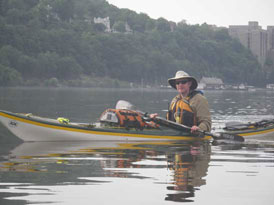Carolina
13.5 by Perception
The Carolina
line is one of the most important series of kayaks ever made. These were the first mass-produced “Day
Touring” boats that bridged the gap between recreational kayaks and longer sea
kayaks. There are lots of Carolinas out
there on the used market, and they come in different sizes. I got to try out a Carolina 13.5. The one I paddled was an older model, 2002,
and had no options (rudder, adjustable seat, adjustable thigh bracing,
etc.). As the Carolina matured, Perception
added more features and options, so the age of the kayak does matter as far as
outfitting is concerned. Although my
Carolina is old, it is still in great shape and has many more years of great
paddling left.
I read the
reviews on this kayak on Paddling.net and was a bit confused when several
people said that it tracked well but is hard to turn. Then I realized that they all came from
paddling 9-10 ft. recreational kayaks. I
paddle sea kayaks mostly, so I will be comparing it to other kayaks that are similar
in size.
After
talking to many people who paddle Carolinas, I expected this kayak to be very
stable and quite sluggish, sort of a glorified recreational boat. I was pleasantly surprised. This kayak was nimble, with only moderate
initial stability (compared to an Acadia or a Pungo) and it has very good
secondary stability. The 13.5 Carolina
is only 22.5” wide, so it handles like a small sea kayak. The cockpit is tight (I am 5’7”, 150lbs and
it was uncomfortable for me. I don’t see
how anyone over 5’5” and 135lbs would be comfortable in this boat.) The thigh bracing gives good contact with the
boat and allows for some great control when edging a turn.
 |
| Newer Carolinas have better outfitting, especially the seat, but still no deck lines. |
I suppose
that compared to recreational kayaks it tracks well and is hard to turn, but
compared to anything in its class (like a Tsunami), the tracking is pretty weak
and it turns on a dime. So it may be a
bit of work to keep in a straight line, but it is really fun to paddle. The flat hull makes this a fairly slow kayak (it
actually throws off a bow wave as it plows through the water), but for most
casual day-touring, it is fast enough.
The total lack of rocker means the kayak will submarine into oncoming
waves, but it says right on the kayak that it is intended for flat or
slow-moving water only, so expecting it to perform well in big waves is asking
a bit much.
By today’s standards, the outfitting is sorely lacking. My Carolina had only 1 adjustment to the seat
back, no adjustments to the thigh bracing, no rudder or skeg, no day hatch, and
no deck lines. Later Carolinas did add
more features, but no deck lines (a big oversight for a touring kayak). With the poor tracking, I can see where
someone might want a rudder on this boat.
Bottom line: Compared to a modern day-touring kayak, like a
Tsunami, the Carolina seems old-fashioned.
It has neither the outfitting nor the performance of a Tsunami. But, it is a comfortable, fun kayak to paddle
and you can pick one up for about half the price of a Tsunami. Another plus of my Carolina is that it only
weighs 47 lbs. because it doesn’t have a rudder or other extra outfitting to
add weight. If you are looking for an
all-purpose kayak that will take a lot of abuse, give this boat a try. If you are over 5’5” and 135 lbs., try the
Carolina 14’. Though I suspect it is a
bit more sluggish than the 13.5.





